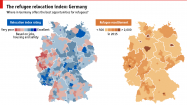Daily chart
OF THE estimated 1m asylum-seekers who arrived in Germany in 2015, a vast proportion headed straight to its big cities, many eventually settling locally as refugees. This was due in part to the personal choices of the new arrivals, but also the German government's allocation strategy which favours locations with sizable populations and tax revenue shares. But large, heavily populated areas may not present the best options, either for the migrants (families in particular), or for Germany as a whole.
Many smaller and more rural areas perform better when it comes to employment opportunities and housing availability, while a good number also offer a greater level of safety, but most asylum seekers simply don't know where these more “liveable” areas are. According to Lukas Weiden from Empirica research institute, the chances of migrants having relatives or friends already settled in small towns or rural areas is also lower. The result is that they end up moving to the same big cities, which are already expensive and where housing is in short supply. Fears of anti-migrant hostility can also be an influence on destination choice.
In an attempt to identify where Germany’s “ideal” districts for newly-arrived migrant families are located, The Economist has created an index based on alternative measures to those favoured by the German authorities. By merging figures on job and housing availability provided by Empirica, together with data on violent attacks on migrants from German newspaper Die Zeit,we were able to map districts on a scale of the most-to-least suitable for settlement. Alongside, we've mapped Die Zeit's figures showing where migrants actually settled in the first half of 2015. By cross-comparing the districts identified as “good” or "excellent" in our index, a mismatch is exposed which suggests that refugees might indeed be congregating in the wrong places.





No comments:
Post a Comment